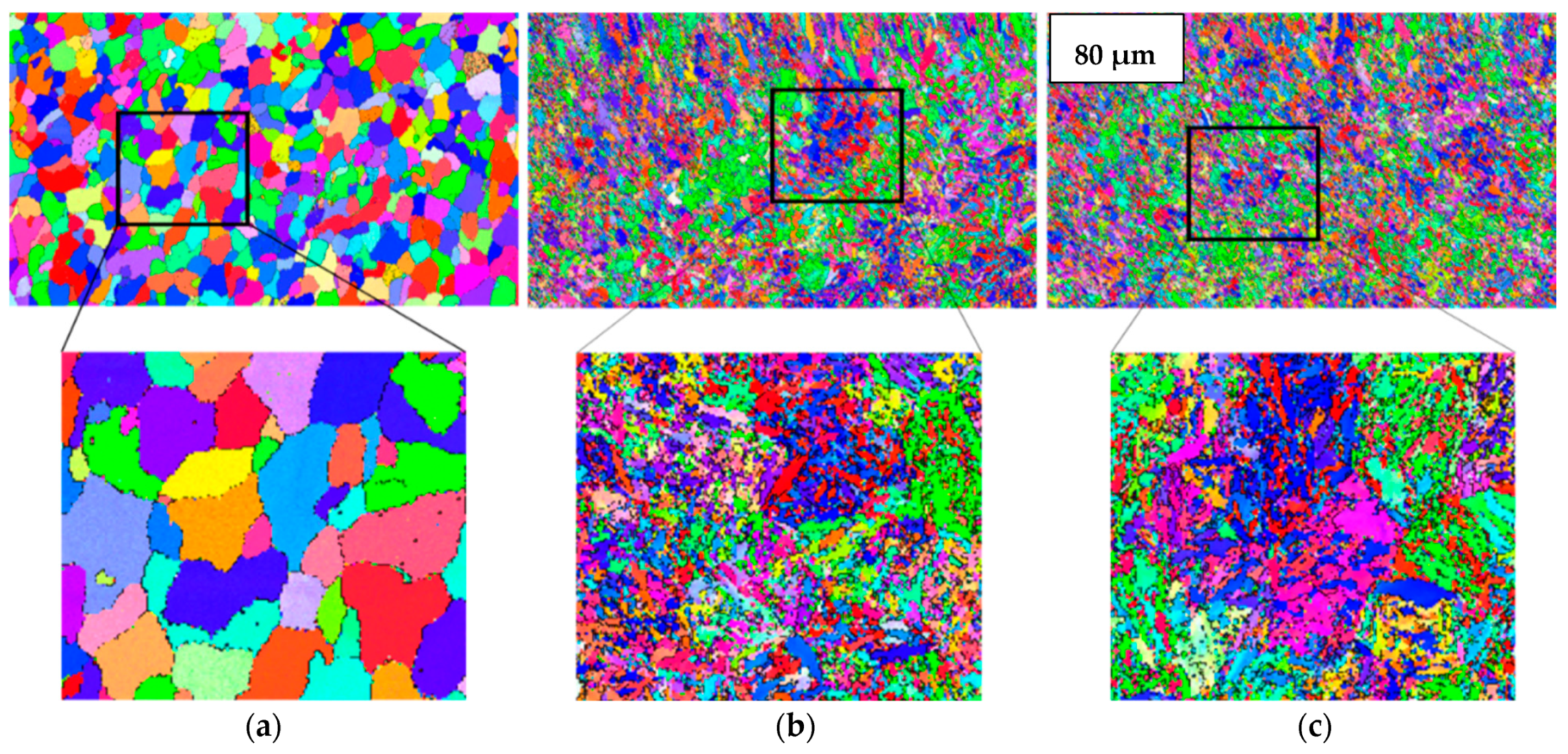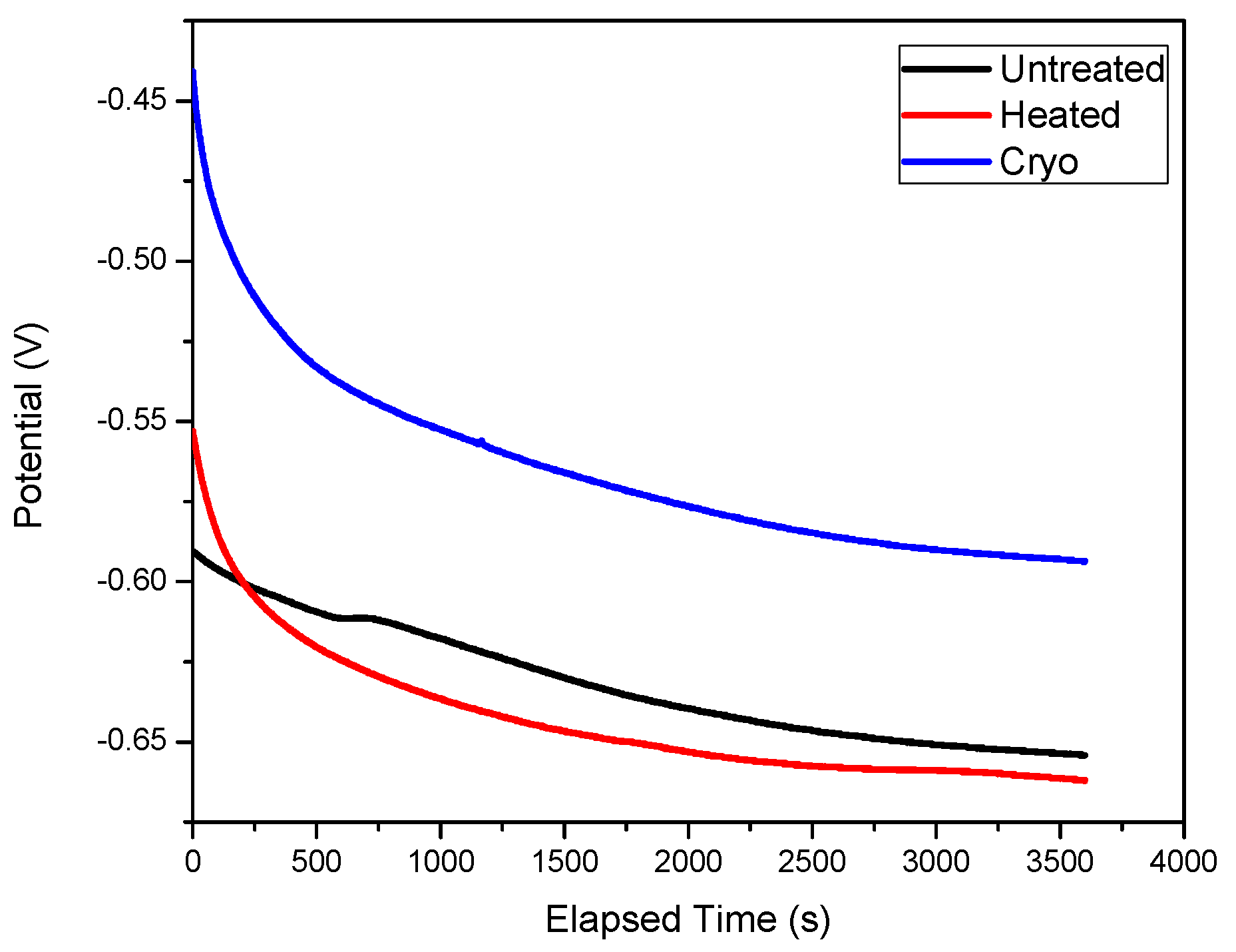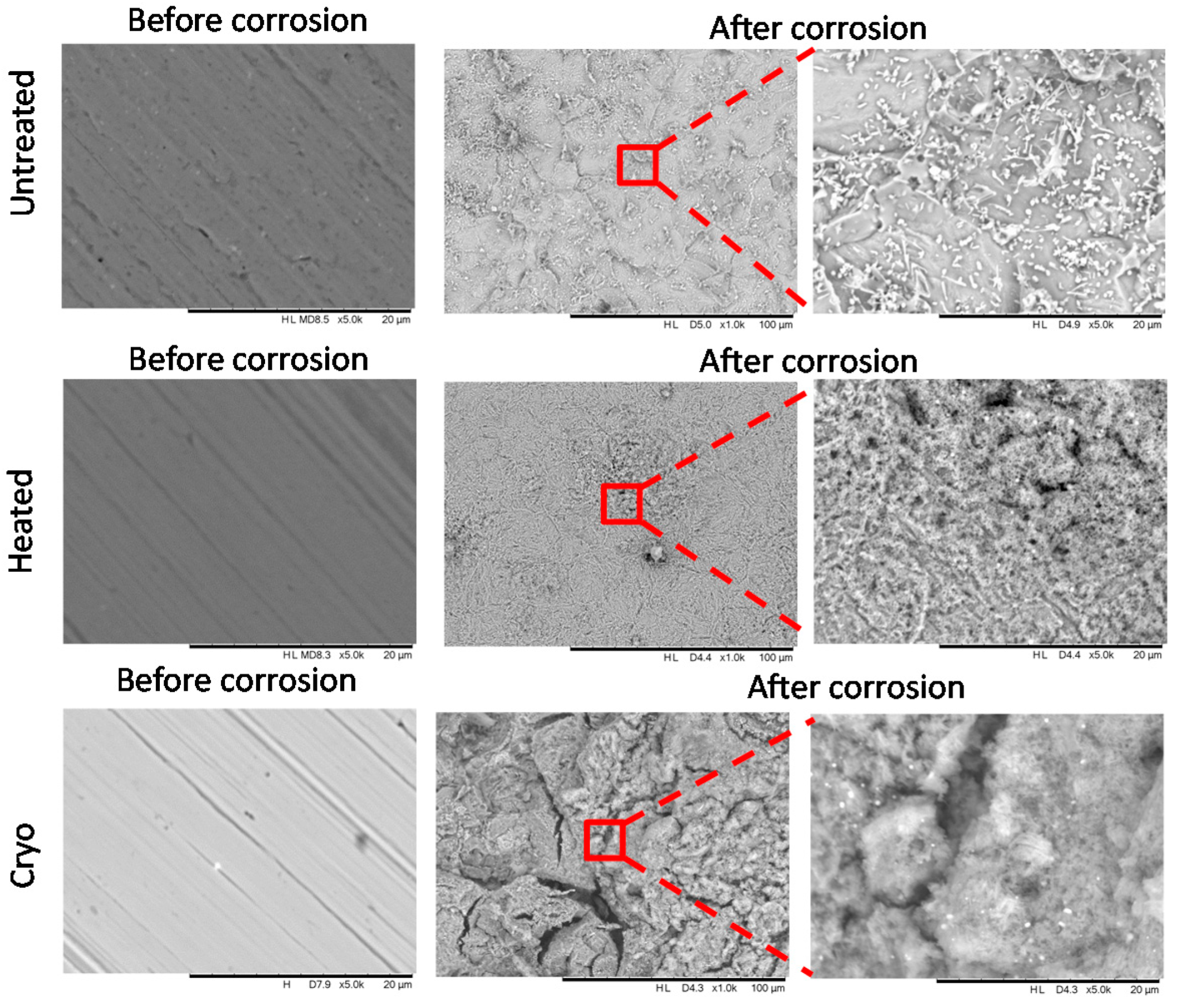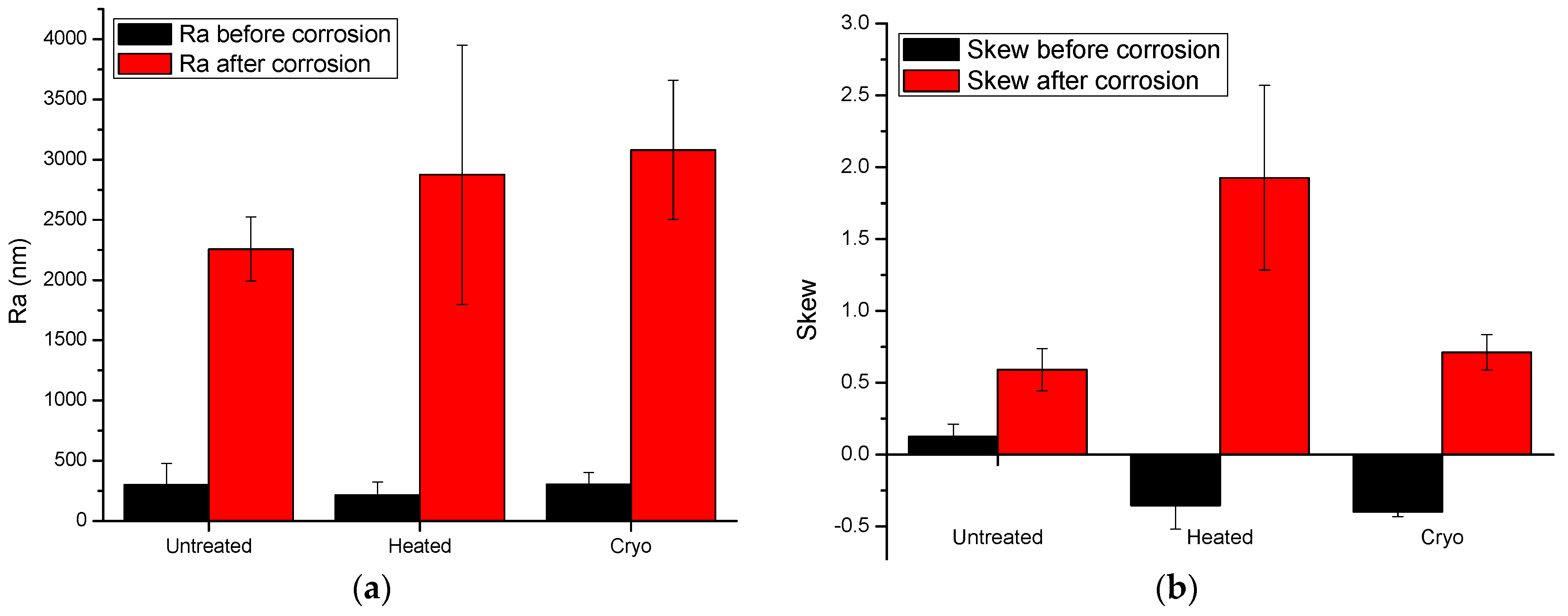Effect of Deep Cryogenic Treatment on Corrosion Behavior of AISI H13 Die Steel
Abstract
:1. Introduction
2. Materials and Methods
2.1. Surface Modification Process
2.2. Characterization Methods of Developed Surfaces
3. Results
3.1. Microstructural Results
3.2. Electrochemical Results
3.3. Morphology before and after Electrochemical Tests
3.4. Roughness before and after Electrochemical Tests
4. Discussion
5. Conclusions
- The deep cryogenic treatment is beneficial in improving the corrosion resistance of AISI H13 material and could be useful in applications involving high mechanical stress and a corrosive environment.
- The grain boundaries decide the corrosion characteristics of the material; increased geometrically necessary dislocations indicate higher plastic straining. There is a reduction in grain size for AISI H13 specimens subjected to 16 h deep cryogenic treatment, which is attributed to the precipitation of fine carbides at the grain boundary areas.
- Parameters such as higher open circuit potential and skewness indicate that H13 specimens subjected to deep cryogenic treatment have a better response to a corrosive environment, whereas the surface porosity measurements and Nyquist plots confirm the superior response of heated specimens to a corrosive atmosphere.
Author Contributions
Funding
Acknowledgments
Conflicts of Interest
References
- Global Tool Steel Market Size by Product Group, by Application, by Geographic Scope and Forecast. 2021. Available online: https://www.verifiedmarketresearch.com/download-sample/?rid=38576 (accessed on 15 November 2021).
- Tool Steel Market Information Report, by Format Type (Round Format, Square Format and Other Format), by Application (Automotive, Machinery and Shipbuilding), by Process (Forged and Rolled) and by Region—Forecast to 2030. 2017. Available online: https://www.marketresearchfuture.com/reports/tool-steel-market/toc (accessed on 15 November 2021).
- Vander Voort, G.F.; Corporation, C.T. Failures of Tools and Dies. ASM Handb. Fail. Anal. Prev. 1986, 11, 563–585. [Google Scholar]
- Kchaou, M.; Elleuch, R.; Desplanques, Y.; Boidin, X.; Degallaix, G. Failure mechanisms of H13 die on relation to the forging process—A case study of brass gas valves. Eng. Fail. Anal. 2010, 17, 403–415. [Google Scholar] [CrossRef]
- Papageorgiou, D.; Medrea, C.; Kyriakou, N. Failure analysis of H13 working die used in plastic injection moulding. Eng. Fail. Anal. 2013, 35, 355–359. [Google Scholar] [CrossRef]
- Mohan Lal, D.; Renganarayanan, S.; Kalanidhi, A. Cryogenic treatment to augment wear resistance of tool and die steels. Cryogenics 2001, 41, 149–155. [Google Scholar] [CrossRef]
- Baldissera, P.; Delprete, C. Deep Cryogenic Treatment: A Bibliographic Review. Open Mech. Eng. J. 2008, 2, 1–11. [Google Scholar] [CrossRef]
- Das, D.; Dutta, A.K.; Ray, K.K. Correlation of microstructure with wear behaviour of deep cryogenically treated AISI D2 steel. Wear 2009, 267, 1371–1380. [Google Scholar] [CrossRef]
- Farhani, F.; Niaki, K.S.; Vahdat, S.E.; Firozi, A. Study of effects of deep cryotreatment on mechanical properties of 1.2542 tool steel. Mater. Des. 2012, 42, 279–288. [Google Scholar] [CrossRef]
- Suchmann, P.; Jandova, D.; Republic, C.; Resistance, W. Deep Cryogenic Treatment of H11 Hot Working Tool. Mater. Tech. 2013, 49, 400–408. [Google Scholar]
- Das, D.; Kumar, K. Structure-property correlation of sub-zero treated AISI D2 steel. Mater. Sci. Eng. A 2012, 541, 45–60. [Google Scholar] [CrossRef]
- Das, D.; Dutta, A.K.; Toppo, V.; Ray, K.K. Effect of Deep Cryogenic Treatment on the Carbide Precipitation and Tribological Behavior of D2 Steel. Mater. Manuf. Process. 2007, 22, 474–480. [Google Scholar] [CrossRef]
- Yan, X.G.; Li, D.Y. Effects of the sub-zero treatment condition on microstructure, mechanical behavior and wear resistance of W9Mo3Cr4V high speed steel. Wear 2013, 302, 854–862. [Google Scholar] [CrossRef]
- Thornton, R.; Slatter, T.; Ghadbeigi, H. Effects of deep cryogenic treatment on the dry sliding wear performance of ferrous alloys. Wear 2013, 305, 177–191. [Google Scholar] [CrossRef]
- Dhokey, N.B.; Nirbhavne, S. Dry sliding wear of cryotreated multiple tempered D-3 tool steel. J. Mater. Process. Technol. 2009, 209, 1484–1490. [Google Scholar] [CrossRef]
- Gill, S.S.; Singh, J.; Singh, R.; Singh, H. Effect of cryogenic treatment on AISI M2 high speed steel: Metallurgical and mechanical characterization. J. Mater. Eng. Perform. 2012, 21, 1320–1326. [Google Scholar] [CrossRef]
- Tier, M.D. Effect of heat and cryogenic treatment on wear and toughness of HSS AISI M2. Integr. Med. Res. 2020, 9, 12354–12363. [Google Scholar]
- Jovičević-Klug, P.; Jovičević-Klug, M.; Podgornik, B. Effectiveness of deep cryogenic treatment on carbide precipitation. J. Mater. Res. Technol. 2020, 9, 13014–13026. [Google Scholar] [CrossRef]
- Jovičević-Klug, P.; Jenko, M.; Jovičević-Klug, M.; Šetina Batič, B.; Kovač, J.; Podgornik, B. Effect of deep cryogenic treatment on surface chemistry and microstructure of selected high-speed steels. Appl. Surf. Sci. 2021, 548, 149257. [Google Scholar] [CrossRef]
- Koneshlou, M.; Meshinchi, K.; Khomamizadeh, F. Effect of cryogenic treatment on microstructure, mechanical and wear behaviors of AISI H13 hot work tool steel. Cryogenics 2011, 51, 55–61. [Google Scholar] [CrossRef]
- Shinde, T.; Dhokey, N.B. Influence of carbide density on surface roughness and quasi-stable wear behaviour of H13 die steel. Surf. Eng. 2017, 33, 944–952. [Google Scholar] [CrossRef]
- Gök, M.S.; Küçük, Y.; Erdoğan, A.; Öge, M.; Kanca, E.; Günen, A. Dry sliding wear behavior of borided hot-work tool steel at elevated temperatures. Surf. Coat. Technol. 2017, 328, 54–62. [Google Scholar] [CrossRef]
- Molinari, A.; Pellizzari, M.; Gialanella, S.; Straffelini, G.; Stiasny, K.H. Effect of deep cryogenic treatment on the mechanical properties of tool steels. J. Mater. Process. Technol. 2001, 118, 350–355. [Google Scholar] [CrossRef]
- Shinde, T.; Dhokey, N.B. Influence of Tertiary Carbides on Improving Fatigue Limit of H13 Die Steels. Metallogr. Microstruct. Anal. 2017, 6, 398–406. [Google Scholar] [CrossRef]
- Zhirafar, S.; Rezaeian, A.; Pugh, M. Effect of cryogenic treatment on the mechanical properties of 4340 steel. J. Mater. Process. Technol. 2007, 186, 298–303. [Google Scholar] [CrossRef]
- Akhbarizadeh, A.; Amini, K.; Javadpour, S. Effects of applying an external magnetic field during the deep cryogenic heat treatment on the corrosion resistance and wear behavior of 1.2080 tool steel. Mater. Des. 2012, 41, 114–123. [Google Scholar] [CrossRef]
- Molinari, A.; Pellizzari, M.; Straffelini, G.; Pirovano, M. Corrosion behaviour of a surface-treated AISI H11 hot work tool steel in molten aluminium alloy. Surf. Coat. Technol. 2000, 126, 31–38. [Google Scholar] [CrossRef]
- Dobrzanski, L.A.; Polok, M.; Panjan, P.; Bugliosi, S.; Adamiak, M. Improvement of wear resistance of hot work steels by PVD coatings deposition. J. Mater. Process. Technol. 2004, 155–156, 1995–2001. [Google Scholar] [CrossRef]
- Al-Ghyamah, A.; Alodan, M. Electrochemical Characterization of Heat Treated Steel. J. King Saud Univ. Eng. Sci. 2008, 20, 61–67. [Google Scholar] [CrossRef]
- Günen, A.; Karahan, İ.H.; Karakaş, M.S.; Kurt, B.; Kanca, Y.; Çay, V.V.; Yıldız, M. Properties and Corrosion Resistance of AISI H13 Hot-Work Tool Steel with Borided B4C Powders. Met. Mater. Int. 2019, 26, 1329–1340. [Google Scholar] [CrossRef]
- Ramesh, S.; Bhuvaneshwari, B.; Palani, G.S.; Lal, D.M.; Mondal, K.; Kumar, R. Enhancing the corrosion resistance performance of structural steel via a novel deep cryogenic treatment process. Vacuum 2019, 159, 468–475. [Google Scholar] [CrossRef]
- Wright, S.I.; Nowell, M.M. EBSD Image Quality Mapping. Microsc. Microanal. 2014, 12, 72–84. [Google Scholar] [CrossRef] [PubMed]
- Rohrer, G.S. Measuring and Interpreting the Structure of Grain-Boundary Networks. J. Am. Ceram. Soc. 2011, 94, 633–646. [Google Scholar] [CrossRef]
- Adams, B.L.; Wright, S.I.; Kunze, K. Orientation Imaging: The Emergence of a New Microscopy. Metall. Trans. A 1993, 24, 819–831. [Google Scholar] [CrossRef]
- Schwartz, A.J.; Kumar, M.; Adams, B.L.; Field, D.P. (Eds.) Electron Backscatter Diffraction in Materials Science; Springer: Boston, MA, USA, 2009. [Google Scholar]
- Tochigi, E.; Nakamura, A.; Shibata, N.; Ikuhara, Y. Dislocation Structures in Low-Angle Grain Boundaries of α-Al2O3. Crystals 2018, 8, 133. [Google Scholar] [CrossRef] [Green Version]
- Sutton, A.P.; Balluffi, R.W. Interfaces in Crystalline Materials; Clarendon Press: Oxford, UK, 1995. [Google Scholar]
- Kundu, A.; Field, D.P. Geometrically Necessary Dislocation Density Evolution in Interstitial Free Steel at Small Plastic Strains. Metall. Mater. Trans. A 2018, 49, 3274–3282. [Google Scholar] [CrossRef]
- Das, D.; Dutta, A.K.; Ray, K.K. On the refinement of carbide precipitates by cryotreatment in AISI D2 steel. Philos. Mag. 2009, 89, 55–76. [Google Scholar] [CrossRef]
- Ralston, K.D.; Birbilis, N. Effect of Grain Size on Corrosion: A Review. Corrosion 2010, 66, 075005. [Google Scholar] [CrossRef]
- Yun-wei, H.A.O.; Bo, D. Effect of Surface Mechanical Attrition Treatment on Corrosion Behavior of 316 Stainless Steel. J. Iron Steel Res. Int. 2009, 16, 68–72. [Google Scholar]
- Pisarek, M.; Kędzierzawski, P.; Janik-Czachor, M.; Kurzydłowski, K.J. Effect of hydrostatic extrusion on passivity breakdown on 303 austenitic stainless steel in chloride solution. J. Solid State Electrochem. 2009, 13, 283–291. [Google Scholar] [CrossRef]
- Afshari, V.; Dehghanian, C. Effects of grain size on the electrochemical corrosion behaviour of electrodeposited nanocrystalline Fe coatings in alkaline solution. Corros. Sci. 2009, 51, 1844–1849. [Google Scholar] [CrossRef]
- Wang, X.Y.; Li, D.Y. Mechanical, electrochemical and tribological properties of nano-crystalline surface of 304 stainless steel. Wear 2003, 255, 836–845. [Google Scholar] [CrossRef]
- Hadzima, B.; Estrin, Y.; Seop, H. Microstructure and corrosion properties of ultrafine-grained interstitial free steel. Mater. Sci. Eng. A 2007, 462, 243–247. [Google Scholar] [CrossRef]
- Atrens, A. Understanding the Corrosion of Mg and Mg Alloys; Elsevier: Amsterdam, The Netherlands, 2018. [Google Scholar]
- Yate, L.; Coy, L.E.; Aperador, W. Robust tribo-mechanical and hot corrosion resistance of ultra-refractory Ta-Hf-C ternary alloy films. Sci. Rep. 2017, 7, 3080. [Google Scholar] [CrossRef] [PubMed]
- Pruncu, C.I.; Braic, M.; Dearn, K.D.; Farcau, C.; Watson, R.; Constantin, L.R.; Balaceanu, M.; Braic, V.; Vladescu, A. Corrosion and tribological performance of quasi-stoichiometric titanium containing carbo-nitride coatings. Arab. J. Chem. 2017, 10, 1015–1028. [Google Scholar] [CrossRef]
- Vladescu, A.; Vranceanu, D.M.; Kulesza, S.; Ivanov, A.N.; Bramowicz, M.; Fedonnikov, A.S.; Braic, M.; Norkin, I.A.; Koptyug, A.; Kurtukova, M.O.; et al. Influence of the electrolyte’s pH on the properties of electrochemically deposited hydroxyapatite coating on additively manufactured Ti64 alloy. Sci. Rep. 2017, 7, 16819. [Google Scholar] [CrossRef] [PubMed]
- ASTM G102-89(2015)e1 Standard Practice for Calculation of Corrosion Rates and Related Information from Electrochemical Measurements; ASTM International: West Conshohocken, PA, USA, 2015.
- Handoko, W.; Pahlevani, F.; Sahajwalla, V. Materials Enhancing Corrosion Resistance and Hardness Properties of Carbon Steel through Modification of Microstructure. Materials 2018, 11, 2404. [Google Scholar] [CrossRef] [PubMed] [Green Version]










| Sample | Ei = 0 (mV) | icorr (µA/cm2) | Rp (kΩ) | P | Pe (%) | CR (µm/year) |
|---|---|---|---|---|---|---|
| Untreated | −865 | 4.387 | 11.644 | - | - | 0.051 |
| Heated | −835 | 1.303 | 20.917 | 0.532 | 70.3 | 0.015 |
| Cryo | −906 | 2.005 | 9.130 | 1.199 | 54.3 | 0.023 |
Publisher’s Note: MDPI stays neutral with regard to jurisdictional claims in published maps and institutional affiliations. |
© 2021 by the authors. Licensee MDPI, Basel, Switzerland. This article is an open access article distributed under the terms and conditions of the Creative Commons Attribution (CC BY) license (https://creativecommons.org/licenses/by/4.0/).
Share and Cite
Shinde, T.; Pruncu, C.; Dhokey, N.B.; Parau, A.C.; Vladescu, A. Effect of Deep Cryogenic Treatment on Corrosion Behavior of AISI H13 Die Steel. Materials 2021, 14, 7863. https://doi.org/10.3390/ma14247863
Shinde T, Pruncu C, Dhokey NB, Parau AC, Vladescu A. Effect of Deep Cryogenic Treatment on Corrosion Behavior of AISI H13 Die Steel. Materials. 2021; 14(24):7863. https://doi.org/10.3390/ma14247863
Chicago/Turabian StyleShinde, Tarang, Catalin Pruncu, Narendra B. Dhokey, Anca C. Parau, and Alina Vladescu. 2021. "Effect of Deep Cryogenic Treatment on Corrosion Behavior of AISI H13 Die Steel" Materials 14, no. 24: 7863. https://doi.org/10.3390/ma14247863






.jpg)

